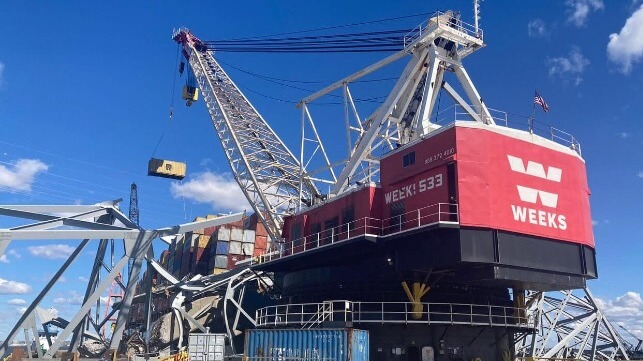East Coast Container Rates Are Getting Cheaper Despite Baltimore Shutdown

As predicted by many shipping analysts, the shutdown of the Port of Baltimore has not significantly affected container rates to the U.S. East Coast, and other nearby seaports have had adequate handling capacity to pick up the slack. Far from a pandemic-like price spike, the rates on core Asia-USEC routes have actually declined since Baltimore's inner harbor shut down, according to freight intelligence firm Xeneta.
On March 26, the boxship Dali struck a pier on the Francis Scott Key Bridge, collapsing the through-truss span and killing six road workers. The wreckage closed the harbor to deep-draft traffic, including container ships. All terminals are shut to water-side commerce, with the exception of Tradepoint Atlantic, a ro/ro and breakbulk port located seaward of the bridge.
After the collapse, multiple public officials warned of national economic disruption from the shutdown of the harbor. While the local effects are serious - thousands of Baltimore longshoremen are out of work - and shippers with diverted containers have to pay more for trucking, there appears to be no systemic effect on freight transport to and from the East Coast, based on Xeneta's data.
"Spot rates have not reacted but that doesn’t mean shippers with cargo heading to Baltimore are not affected – on the contrary they are seeing containers arriving at ports they were not expecting," said Xeneta chief analyst Peter Sand. “The majority of containers will now be handled at New York / New Jersey because many of the ships originally bound for Baltimore would have been stopping there anyway, which is perhaps why we haven’t seen an upwards impact on rates."
Spot rates from the Far East to the U.S. Northeast are down by about one percent since the bridge collapsed, according to Xeneta, and are running at $5,400 per forty-foot box. (This is approximately half of the late-pandemic peak.) From Europe to the U.S. Northeast, spot rates are down eight percent.
The changes in container rates are unrelated to any changes in pricing for ro/ro shippers. The Port of Baltimore is the busiest hub for shipping autos and rolling equipment in the United States, and these ro/ro cargoes have no direct connection to containerized freight.
The U.S. Army Corps of Engineers is working on reopening Baltimore's shipping channel, with support from commercial contractors and the U.S. Navy Supervisor of Diving and Salvage. USACE's objective is to clear a 35-foot-deep channel for ro/ro traffic by the end of the month, and fully clear the 50-foot channel for deep sea shipping by the end of May. The reconstruction of the bridge will take far longer, and a political debate is well underway on how to fund it.
